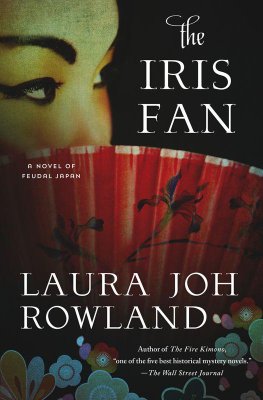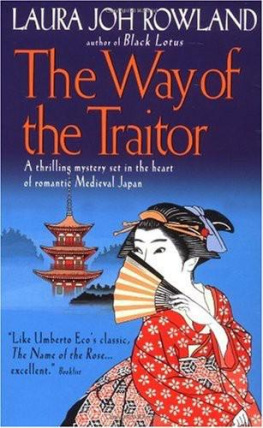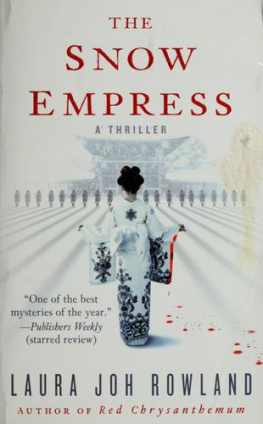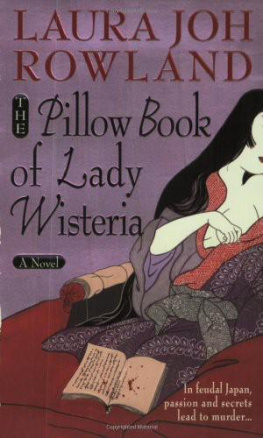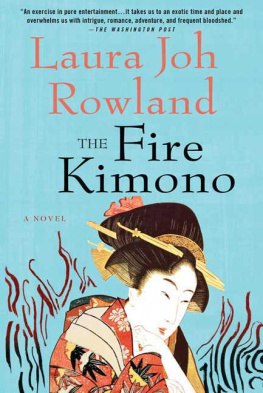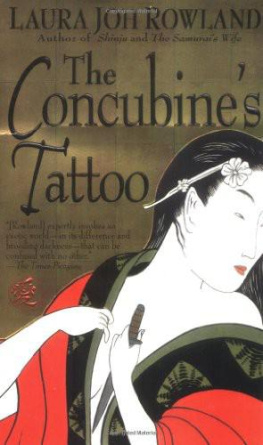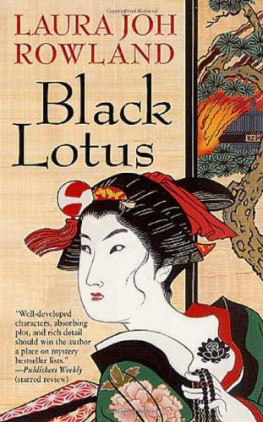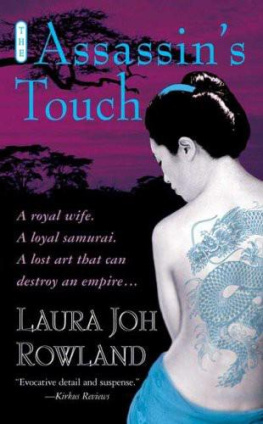Laura Rowland - The Shogun's Daughter
Here you can read online Laura Rowland - The Shogun's Daughter full text of the book (entire story) in english for free. Download pdf and epub, get meaning, cover and reviews about this ebook. genre: Detective and thriller. Description of the work, (preface) as well as reviews are available. Best literature library LitArk.com created for fans of good reading and offers a wide selection of genres:
Romance novel
Science fiction
Adventure
Detective
Science
History
Home and family
Prose
Art
Politics
Computer
Non-fiction
Religion
Business
Children
Humor
Choose a favorite category and find really read worthwhile books. Enjoy immersion in the world of imagination, feel the emotions of the characters or learn something new for yourself, make an fascinating discovery.

- Book:The Shogun's Daughter
- Author:
- Genre:
- Rating:5 / 5
- Favourites:Add to favourites
- Your mark:
- 100
- 1
- 2
- 3
- 4
- 5
The Shogun's Daughter: summary, description and annotation
We offer to read an annotation, description, summary or preface (depends on what the author of the book "The Shogun's Daughter" wrote himself). If you haven't found the necessary information about the book — write in the comments, we will try to find it.
The Shogun's Daughter — read online for free the complete book (whole text) full work
Below is the text of the book, divided by pages. System saving the place of the last page read, allows you to conveniently read the book "The Shogun's Daughter" online for free, without having to search again every time where you left off. Put a bookmark, and you can go to the page where you finished reading at any time.
Font size:
Interval:
Bookmark:
Laura Joh Rowland
The Shogun's Daughter
Historical Note
A streak of misfortune began for Japan with the great earthquake of December 1703, which leveled most of Edo, caused a giant tsunami, and killed thousands of people. In a ritualistic attempt to usher in better times, the government changed the name of the era from Genroku to Hei. It didnt help. In May 1704, the shoguns daughter, Tsuruhime, died at age twenty-seven. Her husband died a month later. Tsuruhimes death had serious ramifications for the future of the Tokugawa regime. She was the shoguns only child. It was unlikely that he would sire any others. Tsuruhimes death cost him the chance of a grandson to inherit the throne. Faced with his own mortality, he was under pressure to name a successor. Some historical sources say that Chamberlain Yanagisawa, the shoguns longtime advisor, tried to pass his son, Yoshisato, off as the shoguns son. Had he succeeded, Yoshisato would have become the next shogun, and Yanagisawa would have ruled Japan through him. Other sources debunk this story. If Yanagisawa did try such an audacious scheme to seize power, it didnt work. The shogun adopted his nephew, Tokugawa Ienobu, and designated him as the official heir and successor. However, the troubles continued. In July 1704 Lady Keisho-in, the shoguns mother, died at age seventy-eight. In 1707 another earthquake struck Japan, and Mount Fuji erupted. In 1709 the shogun died of measles, during an epidemic. Ienobu became shogun. The Shoguns Daughter is an episode in my story of what might have happened during those tumultuous times.
Prologue
Edo, Month 4, Hei Year 1
(Tokyo, May 1704)
Moans filled a chamber lit by a single dim lantern. On the bed, an emaciated young woman writhed under the quilt. Her face was an ugly mask of swollen pustules, covered by gray membranes, that clustered on her features, sealed her eyes shut, and preyed on her mouth like leeches. Pustules on her scalp oozed bloody fluid through her cropped hair onto her pillow. She whimpered in agony, fever, and delirium.
A nurse dressed in a blue cotton kimono, a white drape shrouding her face, knelt by the bed. She patted the sick young womans hands, which wore mitts to prevent her from scratching the pustules, and murmured soothingly. On the tatami floor, one table held basins, soiled cloths, and ceramic jars of medicine; another supported an array of brass incense burners. The smoke from these saturated the air with bitter, astringent haze intended to banish the evil spirits of disease. On the walls, in murals of marsh scenes, herons, geese, and cranes peered avidly through the reeds, like carrion birds waiting for a fresh kill. Painted water lilies rotted in the stench of the young womans decaying flesh.
A white gauze curtain hung over the doorway. Beyond this hovered two shadowy figures. Standing in the dark corridor outside the sickroom, they peered through the flimsy barrier that guarded them from contagion. One was a man dressed in sumptuously patterned silk kimono, surcoat, and flowing trousers. Short legs supported his long torso and broad shoulders. The crown of his head was shaved in samurai style; his hair, worn in the customary topknot, gleamed with wintergreen oil. His companion was an old woman. Her modest gray robes clothed a figure as thin and fleshless as a skeleton. Silver-streaked black hair, knotted and anchored with lacquer combs, framed a narrow face whose right side was distorted, its muscles bunched together, the eye half closed as if in pain.
Is there nothing more that can be done for her? the man asked.
There is not, according to the doctors. The womans speech was precise, cultured. They say that smallpox is not always fatal, but Tsuruhime has a bad case. She added in a waspish tone, Which you would have heard, if you had been at home these past few days.
Annoyed and defensive, the man said, I had important things to do.
What could be more important than attending your wife on her deathbed?
The man sucked air through his teeth. At least it shouldnt be long now.
You must be very pleased, the old woman said.
Im not thinking of myself, huffed the man. Im thinking of Tsuruhime. I dont want her to suffer anymore.
What a pity you werent so considerate of her when it might have made a difference.
The man cut an irate glance at the old woman. Thank the gods I wont have to put up with an old busybody like you interfering in my affairs for much longer.
The woman stood as stiffly as a blighted tree in a storm. Her distorted face hardened with her determination to control her temper. You should thank the gods if they dont punish you for your evils someday.
In the chamber, the sick young womans movements stilled. Her whimpers faded to mewls, then ceased. The man and old woman watched in acrimonious silence. The young womans breath rattled loudly, then quieted. Her chest rose and fell for the last time.
The old woman clasped her hand over her mouth. Tears spilled over her fingers. The man puffed his cheeks and blew out a sound that expressed more relief than regret.
The nurse picked up a chopstick wrapped with cotton on the end. She dipped the cotton in a cup of water. She wetted the young womans blistered lips, administering the matsugo-no-mizu-water of the last moment, the final attempt to revive a dead person. The young woman didnt swallow or move. The water trickled off her lips, gleaming in the lantern-light. The nurse looked toward the doorway and shook her head.
The two spectators stood united in apprehension. At least one of them knew this death was more complicated than it seemed. They both knew it would have serious repercussions. The old woman turned to the man. Her streaming eyes were so filled with grief that he couldnt meet them. She spoke in a challenging tone.
Who wants to tell the shogun his daughter is dead?
1
Five months after the earthquake struck Edo, the castle was a giant construction site on its hill above the city. New stone-faced retaining walls braced the ascending tiers of leveled ground. Guard towers atop walls climbed skyward as masons repaired them. Buildings within the compounds on every tier wore grids of bamboo scaffolding in which workers swarmed. Animated by human activity, the castle seemed to move within the scaffolding, like a creature struggling to emerge from a cocoon. All across the sunlit city below rang the noise of saws and hammers-the birth cries of a city rising from the ruins at a furious, reckless pace.
Chamberlain Sano Ichir led a procession of samurai officials toward the palace, at the heart of the castle, on its highest tier. Brown ceramic tile fresh from the kiln gleamed atop new, interconnected structures whose half-timbered walls wore a coat of dazzling white plaster. New saplings replaced trees uprooted during the earthquake or burned by the fires that came afterward. New white gravel covered the paths upon which Sano and his colleagues walked through the din from construction in other parts of the castle. The air scintillated with sawdust motes that settled on the mens black silk ceremonial robes emblazoned with gold family crests, on their shaved crowns and oiled topknots, on the two swords at each waist.
Ohgami Kaoru, member of the Council of Elders that constituted Japans chief governing body, walked up beside Sano. Whats the reason for this emergency assembly?
Hed aged fast since the earthquake, as had almost everyone else Sano knew. Sad wrinkles in his once youthful face matched the premature whiteness of his hair.
Your guess is as good as mine. The earthquake effect hadnt spared Sano, either. At age forty-six he felt twice as old. Every morning when he looked in the mirror, he saw more gray streaks in his black hair, and his shaved crown had a silvery glint. Hed worked night and day, for five months, to rebuild the city and the wide outlying areas devastated by the earthquake.
Font size:
Interval:
Bookmark:
Similar books «The Shogun's Daughter»
Look at similar books to The Shogun's Daughter. We have selected literature similar in name and meaning in the hope of providing readers with more options to find new, interesting, not yet read works.
Discussion, reviews of the book The Shogun's Daughter and just readers' own opinions. Leave your comments, write what you think about the work, its meaning or the main characters. Specify what exactly you liked and what you didn't like, and why you think so.


